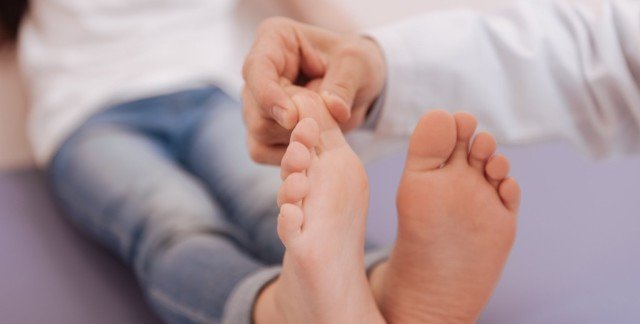Foot Pain
When should I seek treatment for foot pain?
When the pain begins to interfere with your activities of daily living or if you cannot perform your desired activities without pain, you should consider seeking medical attention. Indicators that you should seek medical care are if the area looks deformed, you have loss of function, change of sensation, a large amount of swelling with pain, the affected area becomes warmer than the surrounding areas, becomes exquisitely tender to the touch, or is causing you to move differently.
What causes foot pain?
Foot pain may be caused by many bio-mechanical conditions, or injuries. Acute or repeated trauma, disease, or combinations of the problems are the most common causes of foot pain and are commonly seen in sports and workplace environments that require physical activity.
Trauma is a result of forces outside of the body either directly impacting the body or forcing the body into a position where a single or combination of forces result in damage to the structures of the body. Poor biomechanical alignment may lead to foot pain. Wearing shoes that are too tight or high heels can cause pain around the balls of the feet and the bones in that area. Shoes that are tied too tightly may cause pain and bruising on the top of the foot.
Injuries such as ligament sprains, muscle strains, bruises, and fractures typically occur suddenly (acutely). Sprains, strains, bruises, and fractures may be the result of a single or combination of stresses to the foot. A sprain of the foot or ankle occurs when ligaments that hold the bones together are overstretched and their fibers tear. The looseness of ligaments in the joints of the foot may lead to foot pain.
The muscle's bursa and fascia of the foot can be strained by overstretching, overuse, overloading, bruising, or a cut (such as by stepping on a sharp object). Achilles tendonitis is a common injury of the tendon that attaches at the back of the heel.
Injury to the bones and joints of the foot can be caused by a single blow or twist to the foot, or also by repetitive trauma that can result in a stress fracture. A blunt-force injury such as someone stepping on your foot may result not only in a bruise (contusion) injury but also damage to the muscles and ligaments of the foot. Direct blows to the foot can cause bruising, breaking of the skin, or even fracturing of bones. Metarsalgia is the irritation of the joints of the ball of the foot. The term "stone bruise" is commonly referred to as a specific localized pain and tenderness of the bottom of the foot. "Turf toe" is a common athletic injury in which the tendon under the joint at the base of the big toe is strained. Trauma to the toenail can cause pooling of blood under the nail and the temporary or permanent loss of a toenail. Repetitive trauma to the bones, muscles, and ligaments can result in extra bone growth known as spurs or exostoses.
Sprains, injuries to the ligaments of the foot, occur when ligaments are overstretched. The ligaments that attach the foot to the ankle are also commonly sprained.
Injuries to both the skin covering and the internal structures may also be caused by multiple small repetitive traumas. Micro trauma injuries can be caused by running on uneven surfaces or surfaces that are too hard or too soft, or by wearing shoes that have poor force-absorption qualities or fit incorrectly. Thickenings of tissue of the outer foot and toes are commonly known as bunions, corns, and calluses. These are often caused by poor-fitting shoes.
Repeated overstressing of the same structure of the foot may cause stress fractures, tendonitis, plantar fasciitis, and acute and chronic osteoarthritis. Stress fractures commonly occur in the metatarsal bones, the long bones of the foot.
The arches of the feet absorb and return force to and from the body to the outside world when we are standing on our feet. Injury to the plantar fascia is a common cause of arch pain. The plantar fascia is a tough fibrous sheath that extends the length of the bottom of the foot and lends support to the arch. When the plantar fascia is damaged, the resulting inflammatory response may become a source of arch pain. High and low arches (flat feet) may cause pain because of strain to the feet.




